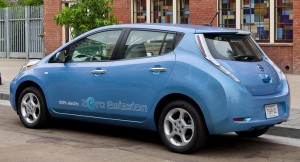Yet another automaker, this time Ford, has announced that it will use liquid heating/cooling to maintain optimum battery temperatures to maximize battery performance and longevity, leaving Nissan even further outside the battery technology mainstream.
Ford said that its 2011 Ford Focus Electric would use a sophisticated liquid system to keep the lithium-ion battery at optimal operating temperatures. Both the Chevrolet Volt and Tesla Motors use liquid to regulate battery temperature.
Nissan is sticking to its plan to use passive air cooling to maintain optimum battery temperature, although cooling technology is downplayed on Nissan’s media Web site. While cheaper than liquid cooling, some critics, most notably Tesla Chairman Elon Musk, have called Nissan’s battery cooling system “primitive.”

Nissan plans to use passive air cooling for thermal management of the battery in its Leaf electric vehicle.
Last month, Musk said on a conference call with investors and analysts that the Leaf’s battery, most notably its thermal management system, is less advanced than Tesla’s very first prototype.
Keeping lithium-ion batteries near normal room temperature of 71 degrees requires a sophisticated heating system for use in extreme cold and cooling system in very cold temperatures. Experts have said that the battery does not need to be at exactly 71 degrees to operate efficiently, but it has to be in the ballpark.
Nissan’s strategy is to make the battery as inexpensive as possible to keep the overall cost of the vehicle down. The company has said its goal is to reduce battery costs from the current level of $18,000 to $9,000. To that end, the Leaf will sell for $32,780, before a $7,500 tax credit. The Volt – which also includes a range-extended gasoline engine – will sell for $41,000 before the federal tax credit and Ford has not announced pricing yet.
Even though it has deemphasized thermal management, Nissan says that its battery will maintain 70-80 percent of its capacity after 8 years, similar to the claims of other manufacturers.
Other companies apparently agree with Musk that thermal management is more important than Nissan does.
Count Ford among them.
“Thermal management of lithium-ion battery systems is critical to the success of all-electric vehicles because extreme temperatures can affect performance, reliability, safety and durability,” says a Ford press release.
On hot days, chilled water absorbs heat from the batteries, dispersing it through a radiator before pumping it through the chiller again. On cold days, heated water warms the batteries, gradually bringing the system’s temperature to a level that allows it to efficiently accept charge energy and provide enough discharge power for expected vehicle performance.
“Extreme temperatures impact a battery’s life and performance, making it crucial to have an effective cooling and heating system to regulate temperature for these demanding applications,” said Anand Sankaran, Ford executive technical leader, Energy Storage and HV Systems.
Focus Electric is one of five electrified vehicles Ford will release over the next three years. In addition to the Focus Electric, the Ford Transit Connect Electric small commercial van arrives in late 2010, followed by two next-generation hybrid electric vehicles, as well as a plug-in hybrid electric vehicle in North America in 2012 and Europe in 2013.
Nissan and Ford claim their Leaf and Focus electrics will have a range of about 100 miles. The Volt, which also uses a lithium-ion battery, will have an all-electric range of 40 miles before its gasoline-powered engine-generator kicks in to provide an additional 300 miles.
Who is right? Only extensive use by consumers will determine if Nissan’s system will provide the promised performance and longevity or if a more sophisticated liquid thermal management system is necessary.

